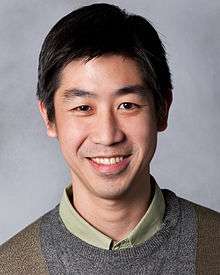Desney Tan
Desney Tan is a Principal Researcher and Director of the Microsoft Research Medical Devices Group.[1] He also holds an affiliate faculty appointment in the Department of Computer Science and Engineering at the University of Washington.[2]
Desney S Tan | |
|---|---|
 | |
| Born | 1976 (age 43–44) |
| Nationality | Singapore |
| Alma mater | Carnegie Mellon University University of Notre Dame |
| Awards | TR35 (2007) |
| Scientific career | |
| Fields | Computer science Human-Computer Interaction |
| Institutions | Microsoft Research |
| Doctoral advisor | Randy Pausch |
Tan was recipient of a National Science and Technology Board Fellowship in 2001, an Agency for Science, Technology, and Research Fellowship in 2002,[3] and a Microsoft Research Fellowship in 2003.[4] He was honored as one of MIT Technology Review's 2007 Young Innovators Under 35 (TR35) in 2007 for his work on Brain Computer Interfaces.[5] He was also named one of SciFi Channel's Young Visionaries at TED 2009, as well as Forbes' Revolutionaries: Radical Thinkers and their World-Changing Ideas for his work on Whole Body Computing.[6] He was the Technical Program Chair of the prestigious ACM SIGCHI Conference in 2008[7] and General Chair in 2011.[8] His research interests primarily focus on Human-Computer Interaction, Physiological Computing, and Healthcare.
Biography
Tan was born and grew up in the Republic of Singapore. He moved to the United States for high school and received his Bachelor of Science in Computer Engineering from the University of Notre Dame in 1996. He then spent sometime in the Singapore Armed Forces. He later attended Carnegie Mellon University, where he earned his PhD in Computer Science in 2004 under the supervision of Randy Pausch, popularly known for delivering "The Last Lecture: Really Achieving Your Childhood Dreams" after being diagnosed with terminal pancreatic cancer.
Work
Tan began his academic career working on robotic path planning, and eventually moved into augmented and virtual reality as well as large display and multiple device user experiences. His PhD dissertation demonstrated the cognitive and social effects of display size, irrespective of the field of view. He is perhaps most well known for his work utilizing bio-sensing to create novel forms of human-computer interfaces. This includes work on: brain-computer interfaces, muscle-computer interfaces, tongue-computer interfaces, bio-acoustic sensing (e.g. in the Skinput project), using the body as an antenna (e.g. in the Humantenna project), as well as work on bionic contact lenses.
Tan has published over 50 technical papers in these various domains, and holds more than 30 associated patents.[9][10][11]
References
- Microsoft Research Medical Devices Group. Retrieved on 2015-09-26.
- University of Washington Computer Science and Engineering Affiliate Faculty. Retrieved on 2012-10-11.
- A*STAR K-Batsu Newsletter Archived 2011-04-25 at the Wayback Machine. Retrieved on 2012-10-11.
- Microsoft Research PhD Fellows. Retrieved on 2012-10-11.
- Technology Review 35 Innovators Under 35: Desney Tan, 31. Retrieved on 2012-10-11.
- Forbes' Revolutionaries: Radical Thinking and their World-Changing Ideas. Retrieved on 2012-10-11.
- ACM CHI 2008 Conference on Human Factors in Computing Systems. Retrieved on 2012-10-11.
- ACM CHI 2011 Conference on Human Factors in Computing Systems. Retrieved on 2012-10-11.
- Desney Tan publications. Retrieved on 2012-10-11.
- Desney Tan - ACM Digital Library profile page. Retrieved on 2012-10-11.
- Desney Tan - Microsoft Academic Search profile page. Retrieved on 2012-10-11.